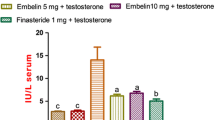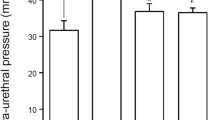Summary
Finasteride is a potent drug which has been prescribed for the management of benign prostatic hyperplasia (BPH) for more than 20 years. Recent studies indicate that finasteride, as 5alpha-reductase inhibitor, can influence some central effects such as analgesia, neurosteroidogeneses and behavior. The purpose of this study was to investigate the analgesic effect of finasteride, to determine whether finasteride interact with morphine analgesia in tail-flick test and to examine the anti-inflammatory effect of this drug. Adult male Wistar rats (280–330 g) were used for the both of experiments. Tests were assessed on groups of 6 animals. The first control group (O) received water (1 ml/kg, p.o.), the second control group (OO) received the vehicle (olive oil, 1 ml/kg, p.o.) and the third group (F) received finasteride (0.5 mg/kg, p.o.) suspended in olive oil, every morning for 30 days. After 30 days of treatment, tailflick test and formalin-induced foot paw edema test were performed. Finasteride increased the average latency in seconds in comparison to both controls (10.06 vs. 9.16 and 8.66 s). It was 9.83% higher depression of pain in group F in comparison to O and 16.17% in comparison to OO, but the anti-nociceptive effect of finasteride at applied dose didn’t significantly differ compared to both controls (p >0.05). Chronic pre-treatment with finasteride didn’t interact with analgesic effect of morphine compared to O (p >0.05), but compared to OO finasteride fastened, increased and prolonged the analgesic effect of morphine at all measuring intervals, achiving statistical significance in 60 min (p<0.01). Finasteride also exhibited significant anti-inflammatory action (p<0.05) in comparison to OO, but It was not significantly different from the control O. Finasteride didn’t exert analgesic action, it increased morphine antinociception and showed chronic anti-inflammatory effect to some extent. This might be a useful contribution to high-light the pathogenesis of BPH. There is the need for further studies in order to confirm these results with more details.
Similar content being viewed by others
References
Andersen J.T., Nickel J.C., Marshall V.R., Schulman C.C., Boyle P. (1997): Finasteride significantly reduces acute urinary retention and need for surgery in patients with symptomatic benign prostatic hyperplasia. Urology, 49, 839–845.
Schafer W., Tammela T.L., Barrett D.M. et al (1999): Continued improvement in pressure-flow parameters in men receiving finasteride for 2 years. Finasteride Urodynamics Study Group. Urology, 54, 278–283.
Andersen J.T., Wolf H., Ekman P. et al. (1996): Finanseride in symptomatic benign prostatic hypertrophy. A 2-year placebo-controlled study. Ugeskr. Laeger., 158, 5030–5035.
Gormley G.J., Stoner E., Bruskewitz R.C. et al. (1992): The effect of finasteride in men with benign prostatic hyperplasia. The Finasteride Study Group. N. Engl. J. Med., 327, 1185–1191.
Rhodes M.E., Frye C.A. (2001): Inhibiting progesterone metabolism in the hippocampus of rats in behavioral estrus decreases anxiolytic behaviors and enhances exploratory and antinociceptive behaviors. Cogn. Affect Behav. Neurosci., 1(3), 287–296.
Poletti A. et al. (1998): 5 alpha-reductase isozymes in the central nervous system. Steroids, 63(5–6), 246–251.
Patte-Mensah C., Penning T.M., Mensah-Nyagan A.G. (2004): Anatomical and cellular localization of neuroactive 5alpha/3alpha-reduced steroid-synthesizing enzymes in the spinal cord. J. Comp. Neurol., 477, 286–299.
Lambert J.J., Beleih D., Peden D.R., Vardy A.W., Peters J.A. (2003): Neurosteroid modulation of GABAA receptors. Prog. Neurobiol., 71, 67–80.
Bortolato M., Frau R., Orru M. et al (2008): Antipsychotic-Like Properties of 5-alpha-Reductase Inhibitors. Neuropsychopharmacology. [Epub ahead of print]
Amini H., Ahmadiani A. (2005): In vivo evidence for an increase in 5alpha-reductase activity in the rat central nervous system following morphine exposure. Int. J. Dev. Neurosci., 23, 621–626.
Verdi J., Ahmadiani A. (2007): Finasteride, a 5alpha-reductase inhibitor, potentiates antinociceptive effects of morphine, prevents the development of morphine tolerance and attenuates abstinence behavior in the rat. Horm. Behav., 51, 605–610.
Lee Keith L., Peehl Donna M. (2004): Molecular and cellular pathogenesis of benign prostatic hyperplasia. J. Urol., 172, 1784–1791.
Untergasser G., Madersbacher S., Berger P. (2005): Benign prostatic hyperplasia: age-related tissue-remodeling. Exp. Gerontol., 40, 121–128.
Kramer G., Marberger M. (2006): Could inflammation be a key component in the progression of benign prostatic hyperplasia? Curr. Opin. Urol., 16, 25–29.
D’Amour F.E., Smith D.L. (1941): A method for determining loss of pain sensation. J. Pharmacol. Exp. Ther., 72, 74–79.
Sauver J.L., Jacobson D.J., McGree M.E., Lieber M.M., Jacobsen S.J. (2006): Protective association between nonsteroidal antiinflammatory drug use and measures of benign prostatic hyperplasia. Am. J. Epidemiol.. 164. 760–768.
Wieseler-Frank J., Maier S.F., Watkins L.R. (2005): Immune-to-brain communication dynamically modulates pain: Physiological and pathological consequences. Brain Behav. Immun., 19, 104–111.
D’Mello R., Dickenson A.H. (2008): Spinal cord mechanisms of pain. Br. J. Anaesth; [Epub ahead of print].
Author information
Authors and Affiliations
Rights and permissions
About this article
Cite this article
Duborija-kovacevic, N., Jakovljevic, V., Sabo, A. et al. Anti-nociceptive and anti-inflammatory properties of 5alpha-reductase inhibitor finasteride in experimental animals. Eur. J. Drug Metabol. Pharmacokinet. 33, 181–186 (2008). https://doi.org/10.1007/BF03191116
Received:
Issue Date:
DOI: https://doi.org/10.1007/BF03191116




